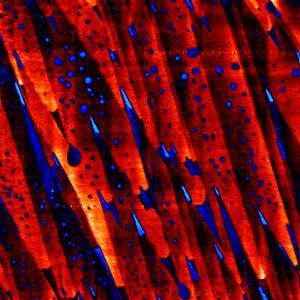

College Park, MD - Earth's climate is strongly influenced by the presence of particles of different shapes and origins - in the form of dust, ice and pollutants - that find their way into the lowest portion of the atmosphere, the troposphere. There, water adsorbed on the surface of these particles can freeze at higher temperatures than pure water droplets, triggering rain and snow.
Researchers at Spain's Centre d'Investigació en Nanociència i Nanotecnologia (CIN2) have studied the underlying mechanisms of water condensation in the troposphere and found a way to make artificial materials to control water condensation and trigger ice formation at room temperature. Described in the Journal of Chemical Physics, which is published by the American Institute of Physics, their work may lead to new additives for snowmaking, improved freezer systems, or new coatings that help grow ice for skating rinks.
"Several decades ago, scientists predicted that materials with crystal faces exhibiting a structure similar to that of hexagonal ice, the form of all natural snow and ice on Earth, would be an ideal agent to induce freezing and trigger rain," explains Dr. Albert Verdaguer. "This explanation has since proven to be insufficient."
The research team chose to study barium fluoride (BaF2), a naturally occurring mineral, also known as "Frankdicksonite," as an option. They examined water adsorption on BaF2 (111) surfaces under ambient conditions using different scanning force microscopy modes and optical microscopy to zoom in on the role atomic steps play in the structure of water films, which can affect the stabilization of water bilayers and, ultimately, condensation.
Despite having the desired hexagonal structure, BaF2 turned out to be a poor ice-nucleating material. But oddly enough, other researchers had discovered that when the mineral's surface has defects, its condensation efficiency is enhanced.
Verdaguer and his colleagues figured out why this occurs. "Under ambient conditions - room temperature and different humidities - we observed that water condensation is mainly induced by the formation of two-dimensional ice-like patches at surface defects," Verdaguer says. "Based on our results and previous research, we're preparing artificial materials to improve water condensation in a controllable way."
The next step? The researchers' goal now is to produce environmentally-friendly synthetic materials for efficiently inducing snow. "If water condenses in an ordered way, such as a hexagonal structure, on such surfaces at ambient conditions, the term 'room temperature ice' would be fully justified," adds Verdaguer. "The solid phase, ice, would be produced by a surface effect rather than as a consequence of temperature. In the long term, we intend to prepare smart materials, 'intelligent surfaces,' that will react to water in a predefined way."
The Journal of Chemical Physics publishes concise and definitive reports of significant research in methods and applications of chemical physics. Innovative research in traditional areas of chemical physics such as spectroscopy, kinetics, statistical mechanics, and quantum mechanics continue to be areas of interest to readers of JCP. In addition, newer areas such as polymers, materials, surfaces/interfaces, information theory, and systems of biological relevance are of increasing importance. Routine applications of chemical physics techniques may not be appropriate for JCP. Content is published online daily, collected into four monthly online and printed issues (48 issues per year); the journal is published by the American Institute of Physics.
M. Cardellach, A. Verdaguer, J. Santiso, and J. Fraxedas:
Two-dimensional wetting: The role of atomic steps on the nucleation of thin water films on BaF2(111) at ambient conditions.
In: Journal of Chemical Physics; J. Chem. Phys. 132, 234708, published online 21 June 2010, DOI 10.1063/1.3456698
Source: American Institute of Physics, AIP